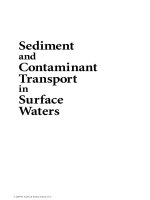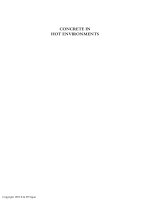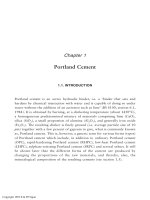CONCRETE IN HOT ENVIRONMENTS - CHAPTER 1 ppsx
Bạn đang xem bản rút gọn của tài liệu. Xem và tải ngay bản đầy đủ của tài liệu tại đây (287.79 KB, 19 trang )
Chapter 1
Portland Cement
1.1. INTRODUCTION
Portland cement is an active hydraulic binder, i.e. a ‘binder that sets and
hardens by chemical interaction with water and is capable of doing so under
water without the addition of an activator such as lime’ (BS 6100, section 6.1,
1984). It is obtained by burning, at a clinkering temperature (about 1450°C),
a homogeneous predetermined mixture of materials comprising lime (CaO),
silica (SiO
2
), a small proportion of alumina (Al
2
O
3
), and generally iron oxide
(Fe
2
O
3
). The resulting clinker is finely ground (i.e. average particle size of 10
µm) together with a few percent of gypsum to give, what is commonly known
as, Portland cement. This is, however, a generic term for various forms (types)
of Portland cement which include, in addition to ordinary Portland cement
(OPC), rapid-hardening Portland cement (RHPC), low-heat Portland cement
(LHPC), sulphate-resisting Portland cement (SRPC) and several others. It will
be shown later that the different forms of the cement are produced by
changing the proportions of the raw materials, and thereby, also, the
mineralogical composition of the resulting cements (see section 1.5).
Copyright 1993 E & FN Spon
1.2. MAJOR CONSTITUENTS
Cement is a heterogeneous material made up of several fine-grained minerals
which are formed during the clinkering process. Four minerals, namely Alite,
Belite, Celite and a calcium-aluminate phase, make up some 90% of the
cement and are collectively known, therefore, as ‘major constituents’.
Accordingly, the remaining 10% are known as ‘minor constituents’.
The structure of the cement constituents is not always exactly known and
in engineering applications their composition is usually written, therefore, in
a simple way as made up of oxides, i.e. in a form which, although representing
their chemical composition, does not imply any specific structure. For
example, the composition of the Alite, which is essentially tricalcium silicate,
is written as 3CaO.SiO
2
. Moreover, in cement chemistry it is usual to describe
each oxide by a single letter, namely, CaO=C, SiO
2
=S, Al
2
O
3
=A, Fe
2
O
3
=F and
H
2
O=H. Accordingly, the tricalcium silicate is written as C
3
S.
The properties of Portland cement are determined qualitatively, but not
necessarily quantitatively, by the properties of its individual constituents and
their content in the cement. Hence, the following discussion deals, in the first
instance, with the properties of the individual constituents, whereas the
properties of the cement, with respect to its composition, are dealt with later
in the text.
1.2.1. Alite
Alite is essentially tricalcium silicate, i.e. 3CaO.SiO
2
or C
3
S. Its content in
OPC is about 45%, and due to this high content, the properties and behaviour
of the latter are very similar to those of Alite. Alite as such is a hydraulic
binder. On addition of water, hydration takes place bringing about setting and
subsequent hardening in a few hours. If not allowed to dry, the resulting solid
gains strength with time mainly during the first 7–10 days. The compressive
strength of the set Alite is comparatively high, ultimately reaching a few tens
of MPa (Fig. 1.1). The hydration of the Alite, similar to the hydration of the
other constituents of the cement, is exothermic with the quantity of heat
liberated (i.e. the heat of hydration) being about 500J/g.
Copyright 1993 E & FN Spon
1.2.2. Belite
Belite in Portland cement is essentially dicalcium silicate, i.e. 2CaO.SiO
2
or
C
2
S. That is, a Belite is a calcium silicate with a poorer lime content as
compared with Alite. Its average content in OPC is about 25%.
On addition of water the Belite hydrates liberating a comparatively small
quantity of heat, i.e. about 250J/g. Belite hydrates slowly and setting may take
a few days. Strength development is also slow and, provided enough moisture
is available, continues for weeks and months. Its ultimate strength, however,
is rather high being of the same order as that of the Alite (Fig. 1.1).
1.2.3. Tricalcium Aluminate
In its pure form tricalcium aluminate (3CaO.Al
2
O
3
or C
3
A) reacts with water
almost instantaneously and is characterised by a flash set which is
accompanied by a large quantity of heat evolution, i.e. about 850J/g. In moist
air most of the strength is gained within a day or two, but the strength, as
such, is rather low (Fig. 1.1). In water the set C
3
A paste disintegrates, and C
3
A
may not be regarded, therefore, as a hydraulic binder. Its average content in
OPC is about 10%. It will be seen later that the presence of C
3
A makes
Portland cement vulnerable to sulphate attack (see section 1.5.3).
1.2.4. Celite
Celite is the iron-bearing phase of the cement and it is, therefore, sometimes
referred to as the ferrite phase. Celite is assumed to have the average composition
Fig. 1.1. Compressive strength of
major constituents of Portland
cement. (Adapted from Ref. 1.1).
Copyright 1993 E & FN Spon
of tetracalcium aluminoferrite (4CaO.Al
2
O
3
.Fe
2
O
3
or C
4
AF) and its average
content in OPC is about 8%.
The Celite hydrates rapidly and setting occurs within minutes. The heat
evolution on hydration is approximately 420J/g. The development of strength
is rapid but ultimate strength.is rather low (Fig. 1.1). Celite imparts to the
cement its characteristic grey colour, i.e. in the absence of the latter phase the
colour of cement is white.
1.2.5. Summary
The different properties of the four major cement constituents are summarised
in Figs 1.1 and 1.2, and in Table 1.1. It may be noted (e.g. Fig. 1.1) that the
compressive strength of both calcium silicates (i.e. C
2
S and C
3
S) is much higher
than the strengths of the C
3
A and the C
4
AF. It can also be noted that the
ultimate strengths of C
2
S and the C
3
S are essentially the same, but the rate of
strength development of the C
3
S is higher than that of the C
2
S. The
considerable differences in the rates of hydration of the different constituents
are reflected in Fig. 1.2. It can be seen that after 24 h approximately 65% of
the C
3
A hydrated as compared to only 15% of the C
2
S. Additional differences
may be noted in some other properties such as the rate of setting, the heat of
hydration, etc. It will be seen later that all these differences are utilised to
produce cements of different properties, i.e. to produce different types of
Portland cement (see section 1.5).
Fig. 1.2. Hydration of Portland cement constituents with time. (Data taken from
Ref. 1.2).
Copyright 1993 E & FN Spon
Table 1.1. Properties of the Major Constituents of Portland Cement
Copyright 1993 E & FN Spon
1.3. MINOR CONSTITUENTS
1.3.1. Gypsum (CaSO
4
·2H
2
O)
It was pointed out earlier (section 1.2.3) that the C
3
A reacts with water almost
instantaneously, bringing about an immediate stiffening of its paste. In OPC
the C
3
A content is about 10%, and this content is high enough to produce
flash set. In order to avoid this, the hydration of the C
3
A must be retarded,
and to this end gypsum is added during the grinding of the cement clinker
(section 1.1). The gypsum combines with the C
3
A to give a high-sulphate
calcium sulphoaluminate, known as ettringite (3CaO·Al
2
O
3
·3CaSO
4
·31H
2
O),
and this formation of ettringite prevents the direct hydration of the C
3
A and
the resulting flash setting.
There is an ‘optimum gypsum content’ which imparts to the cement
maximum strength and minimum shrinkage (Fig. 1.3), and this optimum
depends on the alkali-oxides and the C
3
A contents of the cement and on its
fineness [1.3, 1.4]. On the other hand, the gypsum content must be limited
because an excessive amount may cause cracking and deterioration in the set
cement. This adverse effect is due to the formation of the ettringite which
involves volume increase in the solids. When only a small amount of gypsum
is added, the reaction takes place mainly when the paste or the concrete are
plastic and the associated volume increase can be accommodated without
causing any damage. When greater amounts are added, the formation of the
ettringite, and the associated volume increase, take place also in the hardened
cement and may cause, therefore, cracking and damage. Consequently, cement
standards specify a maximum SO
3
content which depends on the type of
cement considered and its C
3
A content. In accordance with BS12, for
Fig. 1.3. Schematic description of
optimum gypsum content.
Copyright 1993 E & FN Spon
example, this maximum is 2·5 and 3·5%, for low and high C
3
A content
cement, respectively (Table 1.2). Similar restrictions of the SO
3
content, but
not exactly the same, are specified by the relevant ASTM Standard (Table 1.3)
and, indeed, by all cement standards.
In cements with a C
3
A content lower than 6%, the optimum SO
3
content
may be as low as 2% for low alkali contents (i.e. below 0·5%) increasing to
3–4% as the alkali contents rise to 1%. In cements high in C
3
A (i.e. more than
10%) the optimum SO
3
content is about 2·5–3% and 3·5–4% for low and
high alkali contents, respectively [1.5]. It may be noted that the above-
mentioned values are within the limitations imposed by the standards and,
indeed, in the manufacture of Portland cements an attempt is made to add the
gypsum in the amount which imparts to the cement the optimum content.
The optimum gypsum content is temperature-dependent and increases with
an increase in the latter. Hence, the preceding optimum contents are valid only
for conditions where hydration takes place under normal temperatures. This
effect of temperature is demonstrated in Fig. 1.4, and it can be seen that, under
the specific conditions considered, the optimum SO
3
content at 85°C
significantly exceeded the maximum imposed by the standards, and reached
some 7%. It follows that a cement with a SO
3
content which complies with the
standards, would produce a lower strength in a concrete subjected to elevated
temperatures than in otherwise the same concrete subjected to normal
temperatures.
The effect of temperature on optimum SO
3
content is reflected in Fig. 1.4
by the difference S
0
—S
1
, and may partly explain the adverse effect of elevated
temperatures on concrete later-age strength. This adverse effect, however, is
discussed in some detail further in the text (see section 6.6).
Fig. 1.4. Effect of temperature on
optimum SO
3
content. (Adapted
from Ref. 1.6).
Copyright 1993 E & FN Spon
Table 1.2. Required Properties of Portland Cements in Accordance with British Standards
Copyright 1993 E & FN Spon
Copyright 1993 E & FN Spon
Table 1.3. Required Properties of Portland Cements in Accordance with ASTM C150–89
Copyright 1993 E & FN Spon
1.3.2. Free Lime (CaO)
Lime makes up some 65% of the raw materials which are used to produce
Portland cement. On clinkering, however, the lime combines with the other
oxides of the raw materials to give the four major constituents of Portland
cement discussed earlier. The presence of free (i.e. uncombined) lime in the
cement may occur when the raw materials contain more lime than can
combine with the acidic oxides SiO
2,
Al
2
O
3
and Fe
2
O
3,
or when the burning of
the raw materials is not complete. Such incomplete burning may occur, for
example, when the raw materials are not finely ground and intimately mixed.
The presence of free lime in the cement may also result from an excessive
content of phosphorous pentoxide (P
2
O
5
) in the raw materials [1.7].
Nevertheless, even under carefully controlled production, a small amount of
free lime, usually less than 1%, remains in the clinker. Such a lime content,
however, is not harmful.
The uncombined lime which remains in the cement is ‘hard burnt’, and as
such is very slow to hydrate. Moreover, this lime is intercrystallised with other
minerals and is, therefore, not readily accessible to water. Hence, the
hydration of the free lime takes place after the cement has set. Since the
hydration of lime to calcium hydroxide (slaked lime) involves a volume
increase, the expansion of the latter may cause cracking and deterioration.
Cements which exhibit such an expansion are said to be ‘unsound’ and the
phenomenon is known as ‘unsoundness due to lime’.
In view of the preceding discussion, it is clearly understandable that the
free lime content of the cement must be limited. This limitation of the free
lime content is usually imposed in the cement standards by specifying a
minimum expansion of the set cement due to its exposure to curing
conditions that cause the hydration of the free lime in a short time (Table
1.2). A relevant test, using the Le Chatelier apparatus, is described in BS
4550, Part 3, Section 3.7, 1978.
1.3.3. Magnesia (MgO)
The raw materials used for producing cement usually contain a small amount
of magnesium carbonate (MgCO
3
). Similarly to calcium carbonate, the
MgCO
3
dissociates on burning to give magnesium oxide (magnesia) and
carbon dioxide. The magnesia does not combine with the oxides of the raw
materials and mostly crystallises to the mineral known as periclase. At the
Copyright 1993 E & FN Spon
burning temperature of the cement, the magnesia is dead burnt and reacts with
water, therefore, very slowly at ordinary temperatures. As the hydration of the
magnesia (i.e. its conversion to Mg(OH)
2
) involves volume increase, its
presence in the cement in excessive amount may also cause unsoundness.
Consequently, the magnesia content in the cement is limited to a few percent,
i.e. to 4% in accordance with BS 12, 1989 (Table 1.2) or to 6% in accordance
with ASTM C150 (Table 1.3).
1.3.4. Alkali Oxides (K
2
O, Na
2
O)
The alkali oxides are introduced into the cement through the raw materials,
and their content usually varies from 0·5 to 1·3%.
The presence of the alkali in the cement becomes of practical importance
when alkali-reactive aggregates are used in concrete production. Such
aggregates contain a reactive form of silica or, much less frequently, a reactive
form of carbonate, which combines with the alkali oxides of the cement. The
reactions involved produce expansive forces which, in turn, may cause cracking
and deterioration in the hardened concrete (see section 9.4). Generally speaking,
this adverse effect may be avoided by using ‘low-alkali’ cements, i.e. cements in
which the total alkali content, R
2
O, calculated as equivalent to Na
2
O, does not
exceed 0·6%. The molar ratio Na
2
O/K
2
O equals 0·658. Hence, the Na
2
O
equivalent R
2
O content is given by R
2
O=Na
2
O+0·658 K
2
O.
1.4. FINENESS OF THE CEMENT
Fineness of the cement is usually measured by its specific surface area, i.e. by
the total surface area of all grains contained in a unit weight of the cement.
Accordingly, the smaller the grain size, the greater the specific surface area,
and vice versa.
The fineness of the cement affects its properties, and this effect manifests
itself through its effect on the rate of hydration. The hydration of the cement
is discussed later in the text (see section 2.3), but it may be realised that its
rate increases with an increase in the fineness of the cement. The smaller the
cement grains, the greater the surface area which is exposed to water and,
consequently, the higher the rate of hydration.
It will also be shown later (section 6.2.2), that the rate of strength
Copyright 1993 E & FN Spon
development increases with the rate of hydration. It is expected, therefore,
that the rate of strength development will increase with fineness as well. This
is confirmed by the data of Fig. 1.5, which also indicate that the effect of
fineness on strength is greatest at earlier ages, decreasing with time as the
hydration proceeds. At later ages, as will be explained in some detail later in
the text (see section 2.4), the cement grains become encapsulated in a dense
layer of hydration products. This layer retards the diffusion of water, and
thereby slows down hydration until, at some stage, it is stopped completely.
The rate of hydration at this later stage is determined, therefore, by the rate
of water diffusion, and the size of the cement grains becomes of secondary
importance.
1.5. DIFFERENT TYPES OF PORTLAND CEMENT
As has already been mentioned, the properties of Portland cement, which is a
heterogeneous material, are determined, qualitatively at least, by the properties
of its major constituents. The properties of the latter are summarised in Table
1.1 and in Figs 1.1 and 1.2. It can be seen that the C
3
A and C
4
AF contribute
only slightly to the strength of the cement, and that this is particularly true with
respect to later-age strength which is mainly determined by the calcium silicates,
i.e. by the Alite and the Belite. On the other hand, the C
3
A increases the
susceptibility of the cement to sulphate attack, its heat of hydration and
probably its shrinkage as well. Accordingly, it may be concluded that it is
Fig. 1.5. Effect of specific surface area of Portland cement on strength
development in concrete. (Adapted from Ref. 1.8.)
Copyright 1993 E & FN Spon
desirable to increase the total calcium silicates content in the cement at the
expense of the C
3
A and C
4
AF contents, and particularly at the expense of that
of the C
3
A. The reduction in the C
3
A and C
4
AF contents can be achieved by
using raw materials poor in Al
2
O
3
and Fe
2
O
3
. Such a reduction, however, is
practical only to a limited extent because the presence of both Al
2
O
3
and
Fe
2
O
3
in the raw materials lowers the clinkering temperature and is required,
therefore, for economic and technical reasons. Consequently, the combined
content of the calcium silicates is usually kept between 70 and 75% and that
of the C
3
A and the C
4
AF between 15 and 20%. That is, in changing the
cement composition, a variation in the C
3
S content usually involves a
corresponding variation in the opposite direction in the C
2
S content. Similarly,
a variation in the C
3
A content usually involves an opposite variation in the
C
4
AF content (Table 1.4). Nevertheless, within these limitations, the
composition of Portland cement can be changed to produce cements of
different properties, i.e. to produce different types of Portland cement. In
addition to ‘ordinary’ (sometimes ‘normal’) Portland cement, RHPC, LHPC,
SRPC and white cements are produced.
1.5.1. Rapid-Hardening Cement (RHPC)
This type of cement, type III in accordance with ASTM C150, is characterised
by a higher rate of strength development and, therefore, also by a higher early
strength when compared with OPC (type I in accordance with ASTM C150).
This difference in strength decreases with time and, as long as adequate curing
Table 1.4. Approximate Composition and Fineness Ranges for the Standard
Types of Portland Cements
a
a
Adapted from Ref. 1.9.
b
C
4
AF is actually a solid solution whose composition may vary considerably from one cement
to another.
Copyright 1993 E & FN Spon
is provided, both types may reach essentially the same level of strength (Fig.
1.6). This is usually the case when both cements are roughly of the same
fineness, but when the RHPC is ground to a greater fineness, its strength may
remain higher at later ages as well, and particularly when short curing periods
are involved.
RHPC is produced by increasing the C
3
S content at the expense of that of
the C
2
S (Table 1.4), and is usually ground to a greater fineness than the other
types of cement. Accordingly, BS 12, 1989, fo example, specifies a minimum
specific surface area of 350 m
2
/kg for RHPC as compared with 275 m
2
/kg for
OPC (Table 1.2).
The heat of hydration of C
3
S is greater than that of C
2
S. Hence, the heat
of hydration of RHPC is greater than that of OPC. Moreover, the greater
fineness, when this is the case, increases the rate of hydration of RHPC
bringing about a corresponding increase in heat evolution (Fig. 1.7).
1.5.2. Low-Heat Cement (LHPC)
The heats of hydration of C
3
S and C
3
A are higher than those of the remaining
constituents of the cement (Table 1.1). Accordingly, the heat of hydration of
the cement can be lowered by reducing the contents of the C
3
S and the C
3
A
(Table 1.4). It can be seen from Fig. 1.7 that, indeed, heat evolution in such
a cement (type IV in accordance with ASTM C150) is lower than in all other
types of Portland cement.
The heat of hydration of OPC varies from 420 to 500J/g whereas, in
Fig. 1.6. Effect of type of
cement on concrete strength
development. (Adapted from
Ref. 1.10).
Copyright 1993 E & FN Spon
accordance with ASTM C150 and BS 1370, 1979, the heat of hydration of
LHPC should not exceed 250J/g at the age of 7 days and 290 J/g at the age
of 28 days (Tables 1.2 and 1.3).
In view of the comparatively low C
3
S and C
3
A contents in LHPC, it is to
be expected that the rate of strength development in such a cement will be
slow, and consequently its early age strength will be low. This is, of course, the
case. On the other hand, the ultimate strength of LHPC may be even higher
than that of ordinary or RHPC (Fig. 1.6).
The presence of C
3
A makes the cement vulnerable to sulphate attack.
Hence, the reduced C
3
A content improves the sulphate-resisting properties of
LHPC. In fact, as it will be seen in section 1.5.3, the properties of LHPC are
similar to those of sulphate-resisting cement.
1.5.3. Sulphate Resisting Cement (SRPC)
Portland cement is vulnerable to sulphate attack and this vulnerability is
mainly due to the presence of C
3
A. The mechanism of sulphate attack is
described later in the text (see section 9.3.1). This attack, however, involves
volume increase and expansion which, in turn, may cause cracking and
subsequently lead to severe deterioration. It can be seen from Fig. 1.8 that,
indeed, sulphate expansion decreases with the decrease in the C
3
A content and
it is to be expected, therefore, that sulphate resistance of the cement will
increase with a decrease in its C
3
A content. This conclusion is widely
Fig. 1.7. Heat evolution in concrete
made of different types of Portland
cement. (Adapted from Ref. 1.11.)
Copyright 1993 E & FN Spon
recognised and utilised in the production of SRPC, i.e. in the production of
cement type V in accordance with ASTM C150. Accordingly, BS 4027, 1980
limits the C
3
A content in SRPC to 3·5% and ASTM C150–89 to 5% (Tables
1.2 and 1.3).
The presence of the ferrite phase (C
4
AF) also makes the cement vulnerable
to sulphate attack but its effect is much smaller than that of the C
3
A.
Consequently, whereas the C
3
A content of SRPC is always limited, this is not
necessarily the case with respect to the C
4
AF. BS 4027, 1980, for example,
does not impose any limits on the content of the latter. On the other hand,
ASTM C150–89 specifies a maximum content which is related to that of the
C
3
A by the requirement that C
4
AF+2(C
3
A)=25% (Table 1.3).
The reduction in C
3
A content reduces the heat of hydration of the cement
(Fig. 1.7) and brings about slower rate of strength development and a lower
early-age strength. Again, similar to LHPC, the later-age strength of a SRPC
may sometimes be even higher than that of ordinary cement (Fig. 1.6). That
is, SRPC exhibits similar properties to those of LHPC and, indeed, in certain
applications the two are interchangeable. This observation is reflected, to
some extent, in ASTM C150 which also includes a type II cement. This type
is recommended for use when moderate sulphate resistance or, alternatively,
moderate heat of hydration, are required.
1.5.4. White and Coloured Cements
The characteristic grey colour of Portland cement is due mainly to the
presence of the ferrite phase. Accordingly, a white cement is produced by
Fig. 1.8. Effect of C
3
A content on potential
sulphate expansion of Portland cement
mortars after (1) 1 year, and (2) 1 month.
(Adapted from Ref. 1.12.)
Copyright 1993 E & FN Spon
clinkering a mixture of raw materials low in iron oxide, i.e. usually lower than
0·5%. Consequently, the ferrite phase content of the resulting white cement is
in the order of about 1% only. Generally, the strength of the white cement is
lower than that of ordinary cement but, in many cases, it complies with the
strength requirements specified in the standards for OPC.
Coloured cements are produced by grinding together a white clinker with a
suitable pigment, or by blending the white cement with the desired pigment at
a later stage. Both white and coloured cements are expensive to produce and
their use is, therefore, limited to decorative and architectural applications in
which only comparatively small quantities of the cement are required.
1.6. SUMMARY AND CONCLUDING REMARKS
Portland cement is an active hydraulic binder which is produced by clinkering
a mixture of raw materials containing lime (CaO), silica (SiO
2
), alumina
(Al
2
O
3
) and iron oxide (Fe
2
O
3
), and grinding the resulting clinker with a few
percent of gypsum. The cement produced in such a way is a heterogeneous
material which is made of four ‘major constituents’, namely, Alite (essentially
tricalcium silicate), Belite (essentially dicalcium silicate), an aluminate phase
(essentially tricalcium aluminate) and a ferrite phase known as Celite (average
composition approximately tetracalcium aluminoferrite). The combined total
of the four major constituents is approximately 90%. The remaining 10% are
collectively known as ‘minor constituents’, and include, in addition to gypsum
(5%), free lime (1%), magnesia (2%) and the alkali oxides Na
2
O and K
2
O
(1%).
Portland cement is a generic term for various types of cement which
include, in addition to ordinary Portland cement (OPC), rapid-hardening
cement (RHPC), low-heat cement (LHPC), sulphate-resisting cement (SRPC)
and several others. These different types are produced by changing the
composition of the cement and, sometimes, also by grinding the clinker to a
different fineness.
Copyright 1993 E & FN Spon
REFERENCES
1.1. Bogue, R.H. & Lerch, W., Hydration of Portland cement compounds. Ind.
Engng Chem., 26(8) (1934), 837–47.
1.2. Copeland, L.E. & Kantro, D.L., Kinetics of the hydration of Portland cement.
In Proc. Symp. Chem. Cement, Washington, 1960, National Bureau of
Standards Monograph No. 43, Washington, 1962, pp. 443–53.
1.3. Lerch, W., The influence of gypsum on the hydration properties of Portland
cement pastes. Proc. ASTM, 46 (1946), 1252–92.
1.4. Meissner, H.S., et al., The optimum gypsum content of Portland cement. Bull.
ASTM, 169 (1950), 39–45.
1.5. Lea, F.M., The Chemistry of Cement and Concrete (2nd edn). Edward Arnold,
London, UK, 1970, p. 308.
1.6. Verbeck, G. & Copeland, L.E., Some physical and chemical aspects of high
pressure steam curing. In Menzel Symposium on High Pressure Steam Curing
(ACI Spec. Publ. SP 32). ACI, Detroit, USA, 1972, pp. 1–13.
1.7. Gutt, W., Manufacture of Portland cement from phosphatic raw materials. In
Proc. Symp. Chem. Cement, Tokyo, 1968, The Cement Association of Japan,
Tokyo, pp. 93–105.
1.8. Price, W.H., Factors influencing concrete strength. J. ACI, 47(2) (1951), 417–
32.
1.9. ACI Committee 225, Guide to selection and use of hydraulic cements. (ACI
225R-85). In ACI Manual of Concrete Practice (Part 1). ACI, Detroit, MI,
USA, 1990.
1.10. US Bureau of Reclamation, Concrete Manual (8th edn). Denver, CO, USA,
1975, p. 45.
1.11. Verbeck, G.J. & Foster, C.W., Long time study of cement performance in
concrete. The Heats of Hydration of the Cements. Proc. ASTM 50 (1950)
1235–57.
1.12. Mahter, B., Field and laboratory studies of the sulphate resistance of concrete.
In Performance of Concrete, ed. E.G.Swenson. University of Toronto Press,
Toronto, Canada, 1968, pp. 66–76.
Copyright 1993 E & FN Spon









